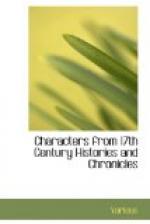l. 21. have bene so much, substituted in MS. for ‘fitt to be more’.
treatises. E.g. Elenchus Motuum Nuperorum in Anglia (part 1), 1649, by George Bate or Bates, principal physician to Charles I and II; England’s black Tribunall. Set forth in the Triall of K. Charles I, 1660; and the sermon mentioned above.
Page 51, l. 20. educated by that people. His tutor was Sir Peter Young (1544-1628), the tutor of James. Patrick Young (1584-1652), Sir Peter’s son, was Royal Librarian.
l. 26. Hambleton. Cf. p. 18, l. 24.
16.
Memoires Of the reigne of King Charles I. With a Continuation
to the
Happy Restauration of King Charles II. By Sir
Philip Warwick, Knight.
Published from the Original Manuscript. With
An Alphabetical Table.
London, 1701. (pp. 64-75.)
Warwick (1609-83) was Secretary to Charles in 1647-8. ’When I think of dying’, he wrote, adapting a saying of Cicero, ’it is one of my comforts, that when I part from the dunghill of this world, I shall meet King Charles, and all those faithfull spirits, that had virtue enough to be true to him, the Church, and the Laws unto the last.’ (Memoires, p. 331.) Passages in the Memoires show that they were begun after the summer of 1676 (p. 37), and completed shortly after May 18, 1677 (p. 403).
Page 55, l. 13. Sir Henry Vane, the elder.
l. 14. dyet, allowance for expenses of living.
Page 56, l. 26. [Greek: Eikon Basilikae]. The Pourtraicture of His Sacred Maiesty in his Solitudes and Sufferings was published in February 1649. Charles’s authorship was at once doubted in Milton’s [Greek: EIKONOKLASTAES] and in [Greek: EIKON ALAETHINAE]. The Pourtraicture of Truths most sacred Majesty truly suffering, though not solely, and supported in [Greek: EIKON AKLASTOS], in [Greek: EIKON AE PISTAE], and in The Princely Pellican, all published in 1649. The weight of evidence is now strongly in favour of the authorship of John Gauden (1605-62), bishop of Exeter at the Restoration. Gauden said in 1661 that he had written it, and examination of his claims is generally admitted to have confirmed them. See H.J. Todd’s Letter concerning the Author, 1825, and Gauden the Author, further shewn, 1829; and C.E. Doble’s four letters in The Academy, May 12-June 30, 1883.
Carlyle had no doubt that Charles was not the author. ’My reading progresses with or without fixed hope. I struggled through the “Eikon Basilike” yesterday; one of the paltriest pieces of vapid, shovel-hatted, clear-starched, immaculate falsity and cant I have ever read. It is to me an amazement how any mortal could ever have taken that for a genuine book of King Charles’s. Nothing but a surpliced Pharisee, sitting at his ease afar off, could have got up such a set of meditations. It got Parson Gauden a bishopric.’—Letter of November 26, 1840 (Froude’s Thomas Carlyle, 1884, vol. i, p. 199).




